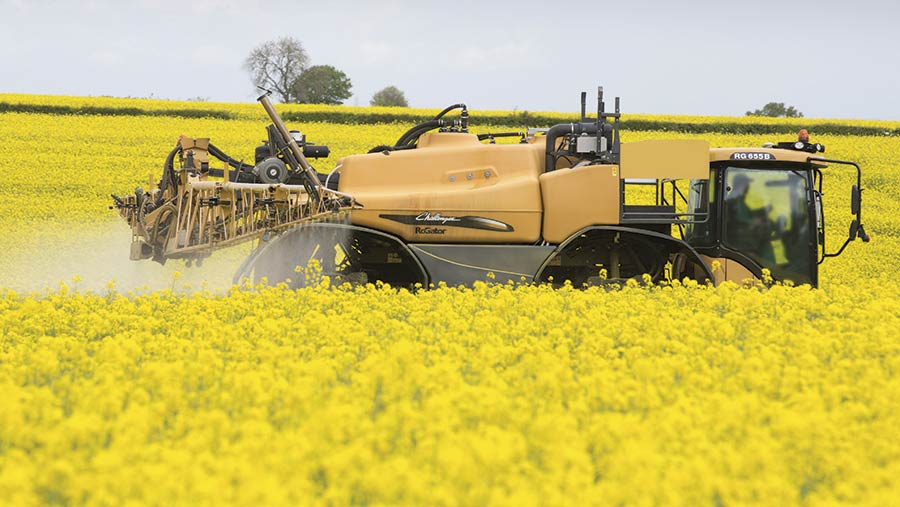Crop Watch: Rapidly advancing crops need regular inspection
 © Tim Scrivener
© Tim Scrivener The recent improvement in weather conditions sees work continuing apace across the country, with spring drilling now well under way and crops advancing rapidly through their growth stages.
In the eastern regions, Marion Self advises applying a protectant fungicide to oilseed rape before petal fall to ward off the risk of sclerotinia.
Antony Wade warns wheat growers in the west to be cautious of their later planted crops, as while they may have less biomass than September sown rivals, they are not far behind in growth stages.
See also: Driver’s view: Derbyshire contractor rates Kellands A280 sprayer
Winter wheat crops are looking big and bulky in the north, so a split application of plant growth regulation is recommended to get some on crops early, says Mary Munro.
Richard Harding has spotted that winter oats crops are seeing higher than normal levels of mildew in the south, and recommends control as soon as possible.
East: Marion Self
Prime Agriculture (Suffolk)
Settled weather has enabled growers to complete spring drilling and catch up with the heavy workload of fertilising and spraying.
Spring seed-beds are good with tilth and moisture underneath, although a good soak would help even establishment, pesticide and fertiliser uptake.
In sugar beet, start the post-emergence herbicide programme with product combinations that can be safely applied at emergence.

This is particularly important in dry conditions where beet emergence is uneven and difficult weeds like knotgrass are already growing. It’s important not to let these weeds get away.
T0 fungicide on winter wheat has been well timed, giving reassurance that crops are protected until a well-timed T1 application (at emergence of final leaf 3) later this month.
Disease pressure is moderate although yellow rust is apparent on susceptible varieties where an earlier fungicide was not applied.
It is important to keep sprays robust, with tight timings between the applications for septoria and rust control, and for resistance management.
Protect flowering oilseed rape
Forward rapeseed crops are now yellow – many will be receiving a fungicide at early to mid-flowering with a view to follow up this treatment later.
Treatments are mainly protectant, the aim is to coat petals before they fall. Warm, unsettled weather will increase the sclerotinia risk.
Crop prices are buoyant, so where yield potential is promising it seems wise to protect this potential.
Continue to monitor for pollen beetle in more backward oilseed rape that is moving slowly from green bud to open flower.
As pyrethroids are generally now considered to give poor control due to resistance non-pyrethroid choices include thiacloprid, pymetrozine and indoxacarb products. Check individual labels for the latest timing of applications.
Continue to check bean crops for pea and bean weevil damage. So far damage has been minimal and crops are growing well. Forward winter beans are budding and will receive the first fungicide treatment at early flower.
West: Antony Wade
AICC (Herefordshire/Shropshire)
Winter barley has been unusually slow to move into spring growth – this may be due to a delay in getting the first fertiliser on these crops in February. This has meant many barley crops have actually been behind early sown winter wheat crops.
In recent seasons I have used a T0 timing for a cheap fungicide input with first spilt of growth regulation.

This season in many cases due to the slow early growth T1 will be the first input, although where wild oats and ryegrass need to be dealt with, early control will be continue to be the strategy.
October sown wheat which was assessed last week looked to have much less stem extension and lower biomass, but leaf 4 emergence is not far behind crops planted in early September.
This reinforces the need for accurate leaf dissection by rolling out rather than splitting stems with a knife and is going to be even more important when we get to leaf 3 applications in mid-April.
Getting some T0 septoria multi-site protection on at this stage allows leaf 3 to fully emerged before applying the T1.
Mildew has been the other disease with noticeable levels so a mildewicide will be added where needed.
High biomass means high yield
Attending many technical meetings over the winter listening to experts and leading growers it has been interesting to hear that there is a good correlation between high biomass and yield in the top yielding wheat crops.
This suggests to me that in these thick crops the T1 timing is much more critical than perhaps previous research has shown.
The AHDB wheat growth guide varieties are no longer grown and it needs updating to reflect modern varieties and this new way of pushing crops to not be source limited.
By setting up crops to achieve a high biomass we are setting up a crop with a huge “source” and therefore we need a crop in good health to set grains in ears so that the “sink” is large enough to fill.
Grains start being set before flag leaf applications are applied hence T1 becomes more critical, so for me SDHIs on leaf 3 are a must on these high potential crops.
North: Mary Munro
AICC/Strutt and Parker (Perthshire)
Some recently sown spring barley should get a pre-emergence Liberator (diflufenican + flufenacet) for annual meadow grass, usually where there is little or no rotation, or in a problem site where the weed is more persistent.
In general, broadleaved weeds will be done at about 2-3 leaf stage of the crop, along with some manganese.

Some growers like to do weeds, manganese, and the T1 all at once – it is possible, but I find if you aim to get the fungicide timing right the weeds can be just about flowering which is hardly ideal.
In winter barley, all the carry-over of dead mildew has gone. The first couple of leaves have died off and fresh growth is clean.
The crops are growing well now. I have a very simple plan for winter barley fungicide – two shots of Siltra Xpro (bixafen and prothioconazole), the first without chlorothalonil, the T2 with chlorothalonil to counter ramularia.
Get plant growth regulation on soon
Winter wheat crops have looked well all winter and are now growing rapidly. Compared to barley, the forward crops are reaching GS 30 with a massive internode from the base, which is one reason to split the growth regulator and get some on early.
The T0 sprays all went on in good time and have done a great job in clearing up septoria and mildew. Planning for T1 is interesting – there are now so many SDHI variations to pick from, mostly priced to be competitive, that a bit of research is required.
I am still a fan of boscalid for its efficacy on eyespot, so it stays in the mix for second wheats, while the first wheats will get Adexar (epoxiconazole + fluxapyroxad) or similar depending on price. T2 will be even more of a challenge I suspect.
South: Richard Harding
Procam (Sussex)
Good progress has been made with spring drilling, warm moist seed-beds allowing spring barley to receive a pre-emergence herbicide of pendimethalin and picolinafen.
Stem extension is well under way in both winter wheat and barley as crops respond to the increasing daylight hours and warmer temperatures.
Septoria levels in wheat are generally low but easily found in most crops and will need suppressing now as will mildew in winter oats, which is present at much higher levels than has been seen in recent years.

T0 applications have been applied to the most forward wheat crops with the majority now applied.
A robust growth regulation programme is essential this year in crops showing an extended basal internode or false node. The developing ear seen clearly sitting above it in dissected plants.
Net blotch and rhynchosporium could be found at high levels in winter barley early in March. These crops have now received a T0 of propiconazole and chlorothalional.
The most forward crops are soon to see this followed with a T1 fungicide based around prothioconazole and trifloxystrobin.
Sclerotinia threat likely to be imminent
Oilseed rape has made some startling growth in the last couple of weeks. Many of the more forward crops have a sheen of yellow across them and at this early flowering stage attention is now focused on sclerotinia.
New sclerotial germination was seen this week at a BASF monitoring site in the South-West, meaning the sclerotinia infection risk could well be imminent on the Downs.
It is essential to monitor the now weekly updates during flowering. The key indicators determining the risk include germination progress, 10 petal test results and weather conditions.
With crops now flowering, attention shifts from pollen beetles towards seed weevils. Control will be factored in when planning early flowering fungicides if the threshold of 0.5-1 weevil per plant is reached.
Cover crops which have suffered with low biomass levels all winter have now (along with crop volunteers) grown very rapidly and, where not terminated ahead of direct drilling, soil conditions beneath these covers appears to be excellent allowing drilling into the green.
It will be interesting to compare the progress of these crops with others where the cover was terminated well in advance of drilling this spring.
Early seed-bed nitrogen for these crops will be essential to allow the emerging crop to grow away unimpeded.

